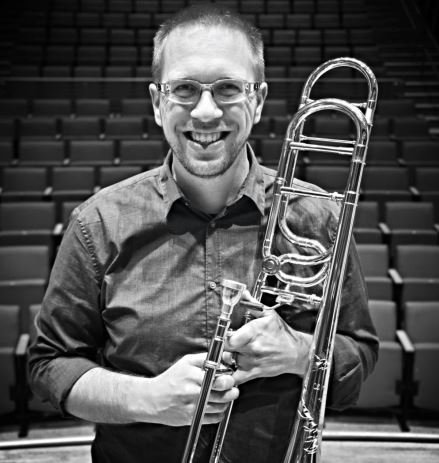
Composer Bio
Dr. James M. David (b. 1978) is an American composer and professor of music theory and composition at Colorado State University. He is particularly known for his works involving winds and percussion. His works have been performed and recorded by many prominent ensembles including the U.S. Air Force Band, the U.S. Army Band “Pershing’s Own”, the U.S. Navy Band, the Des Moines Symphony Orchestra, the Showa Wind Symphony (Japan), the Osaka Shion Wind Orchestra, and the North Texas Wind Symphony. His music has been performed at more than sixty national and international conferences including the Midwest Clinic, the College Band Directors National Association Biennial Conference, the American Bandmasters Association Convention, and the World Association for Symphonic Bands and Ensembles Conference. Dr. David was the winner of the 2022 William D. Revelli Composition Contest, three-time finalist for the Sousa-ABA Ostwald Award, winner of an ASCAP Morton Gould Award, and won national contests sponsored by the Music Teachers National Association and the National Association of Composers (USA). Commissions include projects for the National Band Association, the Atlantic Coast Conference Band Directors Association, Joseph Alessi (New York Philharmonic), John Bruce Yeh (Chicago Symphony), James Markey (Boston Symphony), and hundreds of university faculty and ensembles. His works are represented on over twenty commercially released recordings on the Naxos, Summit, Mark, Albany, Parma, MSR Classics, Bravo Music, GIA Windworks, and Luminescence labels and are published by Murphy Music Press, C. Alan Publications, Potenza Publishing, and Excelsia Music.
As a native of southern Georgia, Dr. David began his musical training under his father Joe A. David, III, a renowned high school band director and professor of music education in the region. This lineage can be heard in his music through the strong influence of jazz and other Southern traditional music mixed with contemporary idioms. Dr. David received degrees in music education and music composition from the University of Georgia and the Florida State University College of Music. He studied composition with Guggenheim recipient Ladislav Kubik, Pulitzer recipient Ellen Taaffe Zwilich, Lewis Nielson, and Clifton Callender as well as jazz composition and arranging with Sammy Nestico.
More information at www.jamesmdavid.com.
Guest Artist Bio
A native of Grand Rapids, Mich., Chris Van Hof is the assistant professor of trombone at Ball State University in Muncie, Indiana, and serves as principal trombone for the Muncie Symphony Orchestra. Chris is a proud performing artist for S. E. Shires Custom Brass Instruments and Facet Mutes Chris leads an active and varied career as a performer in all styles on the trombone and euphonium; a teacher and clinician in brass, chamber music, and jazz; and a writer and arranger of music for ensembles from trombone choir to symphony orchestra. He has performed regularly with the Fort Collins Symphony (CO), the Cheyenne Symphony (WY), and the orchestras Madison, WI, Rochester, NY, as well as the acclaimed Boulder Brass. He recorded two albums with the funk band the Po Boys Brass Band that also included many of his original compositions. He co-founded the Emerald Brass Quintet and still performs with that group throughout the United States. He has played in big bands backing up Johnny Mathis, Slide Hampton, Stefon Harris, Clay Aiken, and Frank Sinatra, Jr. He was principal trombonist on the Eastman Wind Ensemble’s 2008 recording collaboration with the Canadian Brass called Manhattan Music. He has performed internationally as a chamber musician at venues in Panama, Germany, Austria, Hungary, Slovakia, and Finland. For three years, he was the Afternoon Drive Time host of the all-classical-music radio station WXXI Classical 91.5 in Rochester, N.Y. And he has been an associate producer for recordings by artists including flutist Michelle Stanley, tubist Stephanie Frye, euphoniumist Matthew Mireles, and the Madison, Wis.-based Isthmus Brass.
An experienced educator at the collegiate level, Chris has previously taught at Colorado State University (Assistant Professor, 2013-2017), the University of Wisconsin-Platteville (Adjunct, 2012-2013), and Nazareth College (Adjunct, 2008-2011). His students have earned scholarships to reputable music institutions and prominent trombone workshops including the Pokorny Seminar and the Alessi Seminar. He has presented master classes for both college and high school students throughout Colorado, California, New York, Texas, Michigan, Illinois, Indiana, and Wisconsin. Chris is able to teach in both English and Spanish, and was also a faculty member of the 4th Panamanian Trombone Workshop in May 2017 (el 4o Taller de Trombones Panamá).
Program Notes
-
The renowned architect and inventor Buckminster Fuller coined the term "dymaxion" as a combination of Dynamic – Maximum – Tension. He created numerous inventions that expressed this idea, including a highly streamlined automobile that was fancied by the like of Leopold Stokowski and Amelia Earhart.
This short fanfare for concert band utilizes a continually rising scalar motive (not unlike the Shepherd Tone), an oppressive percussion ostinato, and several interlocking polyrhythms to create a continuous crescendo to the final cadence.
This work was commissioned by the Waukee middle School Band, Waukee, Iowa, and dedicated to Mary Crandell, 2022-23 president, Iowa Bandmasters Association.
-
Urban Light is a brilliant display of colors, forward momentum, and intertwining rhythmic layers that is inspired by the iconic Los Angeles landmark of the same name. Created by conceptual art pioneer Chris Burden in 2008, the original work is an assemblage of historic streetlamps that were transplanted from various cities in California and also Portland, Oregon. The tight spacing and repetitive forms interact with the famously dynamic LA sunlight transitioning to the exciting nighttime glow of the city.
Primary melodic and rhythmic motives are derived from Morse code for the word “California,” creating an asymmetrical and syncopated groove that continuously builds in energy. Parallel “barre” chords reveal a classic rock/metal influence that reaches its zenith with a heavy percussion backbeat. Polyrhythmic layers and prismatic colors move over, around, and under each other, leading towards a hopefully thrilling and intense finale.
This work was commissioned by the National Band Association for its 60th anniversary and is dedicated to my wife who introduced me to the West Coast’s beauty and spirit.
-
I will lift up mine eyes unto the hills - from whence cometh my help? – Psalm 121, verse 1
Like so many artists, I have always been drawn to mountains, from the ancient peaks of Appalachia in my native Georgia to the proud Rockies in my adoptive Colorado. The perfect natural analog for struggle and triumph, mountains have long represented a sense of transcendence and spirituality. My trombone concerto Three Summits is an homage to three famous peaks of Colorado and draws on the Southern Gospel music traditions of my youth. Hopefully, a spiritual journey from anguish to elation will be heard in this ambitious solo work for my native instrument.
First is Mount of the Holy Cross seen from Vail Valley, a 14,000-foot peak with a snowfield in the shape of the Christian Cross. This movement depicts an intrepid climb to such a challenging summit by a hearty but youthful mountaineer. A rolling triple rhythm alongside a defiant quartal melody dominates the trudging ascent. Many challenges and shifts of pace are encountered as the trail becomes more and more perilous. At long last, the hiker sees the cross and hums the hymn “The Old Rugged Cross” as the top is finally reached with a breathless “Amen” cadence.
Town of Independence, Population 1 - The ghost town of Independence sits near Colorado’s highest peak, Mt. Elbert, in a pristine alpine valley where only one resident remained after the brutal 1899 winter. Hushed, faintly remembered campfire songs waft through the naked aspens, frozen lakes, and skeletal cabins. The lone pioneer shouts to the heavens the shape note hymn “Wayfaring Stranger” only to fall silent again lost in memory.
Last is the notorious Pikes Peak Hill Climb also known as the Race to the Clouds. Early each summer since 1916, daring auto racers summit the only 14,000-foot Colorado summit accessible by motor vehicle. Raucous engines and death-defying curves provide for an aggressive and white-knuckle ride to the top. A joyous “gospel shout” concludes the concerto with a jangling tambourine backbeat and one more glissando for the trombone. This work was commissioned by a consortium of professional trombonists lead by Dr. Drew Leslie, Colorado State University and Dr. Chris Van Hof, Ball State University.



